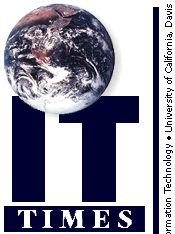
Teaching and Learning Technologies:
Faculty focus on quality instruction
by Margaret Byrne In the last several years, the issue of teaching and technology has gained a strong foothold at UC Davis. A number of events have focused specifically on how technology can enhance teaching and learning. The annual Summer Institute on Technology in Teaching (SITT), which held its fourth conference last summer, fosters a concern for how technology can inspire quality teaching. This theme, which we see gaining momentum at a national -- even international -- level, was chosen for the Chancellor's Fall Conference in 1996 and was followed in Spring 1997 by the All-University Conference, which brought together all nine campuses to examine and discuss teaching and technology.
In the last several years, the issue of teaching and technology has gained a strong foothold at UC Davis. A number of events have focused specifically on how technology can enhance teaching and learning. The annual Summer Institute on Technology in Teaching (SITT), which held its fourth conference last summer, fosters a concern for how technology can inspire quality teaching. This theme, which we see gaining momentum at a national -- even international -- level, was chosen for the Chancellor's Fall Conference in 1996 and was followed in Spring 1997 by the All-University Conference, which brought together all nine campuses to examine and discuss teaching and technology.Themes that spanned both these conferences included access to technology, technology training, competency versus seat-time, accreditation, intellectual property rights, evaluation and assessment of learning, rising costs, faculty incentives and rewards, and distance learning. Some of these topics have been picked up by the Joint Campus Committee on Information Technology (JCCIT).
Rethinking learning
A quick survey of the UC Davis faculty reveals a shift toward integrating technology into the curriculum. Many faculty are using email, discussion lists, and Web sites as communication tools, and some are actively engaged in rethinking how to combine learning and technology. To these instructors, technology is not a separate but an integral part of the modern context.Dedicated both to their students and to experimentation, these faculty transform their entire approach to a course over several quarters. The difficulty -- for them and for all of higher education -- is that every course is fundamentally different. If we are to preserve what is best about education, then the process of transformation will inevitably be time-consuming, labor-intensive, and slow.
Whatever implementations of technology we choose as a campus will need to accommodate both quality of learning and cost savings. We know from the work of peer institutions that integrating technology into some courses can represent significant savings, specifically in terms of capital outlay and the construction and maintenance of new buildings. For example, enrollment at the California State University, which now exceeds 280,000, is predicted to double in the next ten years. To keep pace, the CSU would need to build a new campus every year -- an unlikely scenario. While the UC system does not face quite the same challenge, such trends are bound to have an effect. Appropriate uses of technology offer faculty alternatives in an environment of decreasing options and increasing pressures.
Focusing on quality
UC Davis faculty who use technology in the classroom tend to focus on quality, as one would expect from a major research university. On many campuses one finds the "early adopter" faculty chasing technology trends, but here at UC Davis, technology is rarely the driving force. The underlying goal is the quality of instruction and the appropriateness of technology.
A difficult challenge
The innovators who tend to build the models and lead the way for the rest of the faculty are asking some very tough questions, not only about the role of technology, but about the nature of learning, innovation, and the role of the research university in the next century. If, as a community, we fail to address these questions, we risk a significant reduction in quality and influence; if, on the other hand, we take up the challenge and begin to address the issues before us, we will have the opportunity to provide the nation with a model for the future -- one which integrates innovation in research, education, community involvement, and a full range of learning options.Margaret Byrne is manager of Information Resources' Academic Support Program.